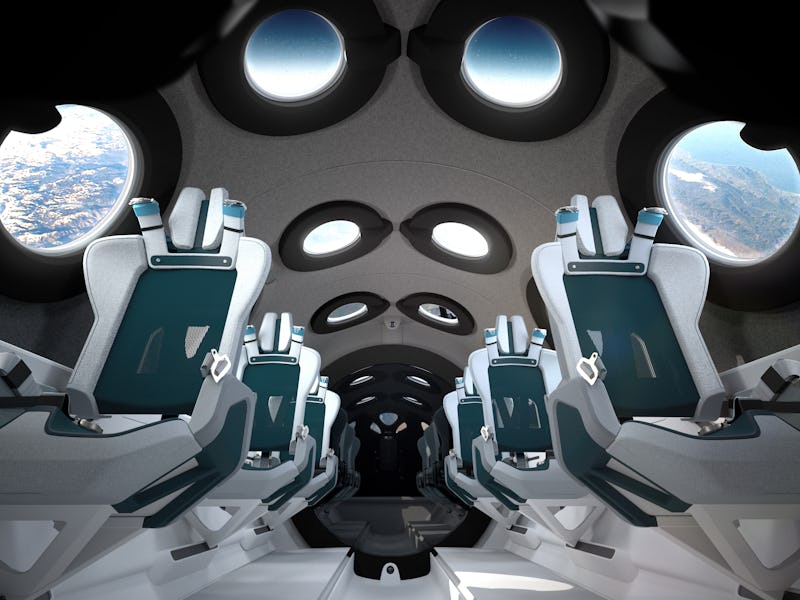Virgin Galactic: Kármán line reveals a heated space travel debate
Virgin Galactic is gearing up to send its founder Richard Branson to space, but there's a debate over where space begins.

Virgin Galactic is about to make its first flight to space — or is it?
On July 1, the company announced that it would host its first fully-crewed spaceflight no earlier than Sunday, July 11. The ship will carry two pilots and four mission specialists, most notably company founder Richard Branson.
It’s the company’s 22nd flight with the VSS Unity ship and the fourth crewed space mission. But it’s that “space” clarifier that’s sparked debate — Virgin Galactic’s flights reach an altitude of just over 55 miles, but some organizations claim the boundary of space is actually 62 miles high.
As competitor Blue Origin prepares to launch its own crewed flight later this month, moving past the 62-mile limit, it’s a debate that could dictate who gets bragging rights.
Want to find out more about the emergent new space race, and competitors like SpaceX and Blue Origin? Subscribe to MUSK READS+ for exclusive interviews and analysis about spaceflight, electric cars, and more.
Virgin Galactic flight: what’s the ongoing rivalry?
CEO Richard Branson’s foray into space tourism with Virgin Galactic is part of an expanding new space race, with new insurgent companies nabbing headlines (and contracts) from an old guard of launch vendors. Where the sixties-era race was more driven by geopolitics and the Cold War, this new race is driven by private companies:
- Jeff Bezos founded Blue Origin in 2000.
- Elon Musk founded SpaceX in 2002.
- Richard Branson founded Virgin Galactic in 2004.
The three have an ongoing rivalry as they race to space.
When Jeff Bezos announced that he and his brother Mark would fly on the first Blue Origin flight, Branson posted on Twitter:
Many congratulations to @JeffBezos & his brother Mark on announcing spaceflight plans. Jeff started building @blueorigin in 2000, we started building @virgingalactic in 2004 & now both are opening up access to Space - how extraordinary! Watch this space…
As is the case with many of these posts, the three will congratulate each other on their achievements — with the occasional hint that they are on their way to impressing as well.
Virgin Galactic flight: what’s the Kármán line?
With Branson confirmed for the July 11 flight, both billionaires are set to beat Musk in personally flying to space — but it’s unclear whether Virgin Galactic will actually make it to space.
The boundary between Earth’s atmosphere and outer space is known as the Kármán line, named after Hungarian engineer Theodore von Kármán. He suggested that there is a line where aerodynamic forces give way to orbital forces, and it is no longer possible to generate lift with an airplane’s wing. This would be a tipping point where space begins.
The Fédération Aéronautique Internationale interprets this line as being 100 kilometers altitude, or 62 miles. The European Space Agency describes this limit as “a generally accepted point that represents the boundary between Earth and space.” That would mean Blue Origin is definitely going to space, but Virgin Galactic misses out.
But others have argued that the line should be lower. Astrophysicist Jonathan McDowell argued in an October 2020 article that the line is actually closer to 80 kilometers, or around 50 miles, based on von Kármán’s original description. That would be good news for Virgin Galactic.
The FAI announced in 2018 that it would explore revisiting the definition and perhaps move the line down to 80 kilometers. Other bodies, like the United States Air Force and NASA, already recognize a lower 50-mile boundary.
So how does this break down for each of the companies?
SpaceX — There’s little question that SpaceX has made it to space. It completed its first crewed mission to the International Space Station, around 250 miles altitude, in May 2020. Of the three, it is the only one capable of orbital flights.
Blue Origin — Blue Origin’s planned crewed flight, on July 20, will send up the New Shepard rocket from the firm’s West Texas facility. A crew capsule will fly to just over 62 miles altitude before returning to Earth. The capsule will move past the 62-mile mark for around 10 minutes. In its January 2021 test, the firm’s capsule reached a maximum altitude of 66 miles.
Virgin Galactic — Virgin Galactic will use the VMS Eve aircraft to lift the VSS Unity spacecraft. The trip will last for around two hours in total, during which the passengers will experience several minutes of weightlessness. In a May 22 flight, the ship reached a maximum altitude of 55.45 miles.
That draws into question whether Virgin Galactic will make it to space.
The flight is expected to follow a similar pattern to previous trips, with the main difference being that Branson will be testing the private astronaut experience. That means the founder will be looking to see what it’s like to ride in the cabin, the experience of the weightlessness, and what it’s like to witness Earth from that perspective.
For now, the question of whether Virgin Galactic will make it to space depends on who you ask.
Virgin Galactic flight: how to watch
Watching along is easy. Fans will be invited to follow along with a livestream, expected to start at 9 a.m. Eastern time.
Viewers can watch in any of these locations:
- On the firm’s main website.
- Via the Twitter page.
- On the Facebook page.
- On the YouTube channel.
Whether Virgin Galactic goes to space or not, it’s sure to be an impressive spectacle.
SUBSCRIBE TO MUSK READS+, A PREMIUM NEWSLETTER THAT COVERS THE WORLDS OF ELON MUSK, SPACEX, TESLA, AND EVERYTHING BETWEEN.
This article was originally published on